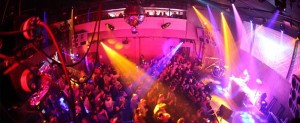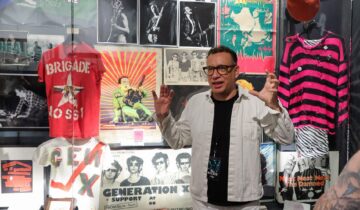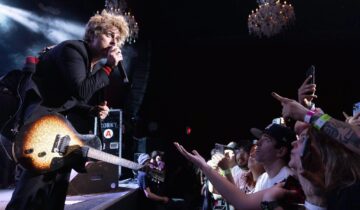 For San Francisco Weekly: At 1015 Folsom, electronic dance music and international music can be heard in five rooms that, in total, can hold roughly 1500 people. The South of Market dance club has been at the same location for 30 years and is right in the epicenter of ongoing, much-needed, much-debated development in San Francisco. In the last few years, the city has changed height limits of buildings and re-zoned South of Market to allow for an increasing amount of residential housing developments of various heights in mixed-use spaces.
For San Francisco Weekly: At 1015 Folsom, electronic dance music and international music can be heard in five rooms that, in total, can hold roughly 1500 people. The South of Market dance club has been at the same location for 30 years and is right in the epicenter of ongoing, much-needed, much-debated development in San Francisco. In the last few years, the city has changed height limits of buildings and re-zoned South of Market to allow for an increasing amount of residential housing developments of various heights in mixed-use spaces.
1015 Folsom owner Ira Sandler gets the occasional noise complaint from neighbors who live within earshot of the club’s windows, but the club is considered in compliance by the Entertainment Commission, the city branch that, among other things, keeps watch over development projects near music venues and other places of entertainment.
When a developer announced plans recently to build an 85-foot residential structure at 363 6th Street near 1015 Folsom, Sandler immediately brought it to the attention of the Entertainment Commission. “I wanted the EC to use their new powers to protect me,” Sandler said.
At a hearing organized by the Commission this October between the developer and Sandler, it was established that the developer had done sound tests that necessitated putting multiple glazing on the windows, and Sandler may need to do a bit of sound mitigation work to his roof. Sandler has since requested to see copies of the tests to verify their accuracy, although he hasn’t received them yet. The project has not yet broken ground.
The hearing is a direct result of Chapter 116, a new law passed by the city at the end of this summer that requires developers in San Francisco to notify the Entertainment Commission and Planning Department of new projects going up near places of entertainment. The law requires developers to participate in hearings with venue owners to determine how noise can be properly mitigated. The law also requires developers to inform new residents that they will be living near a place of entertainment, which hasn’t always happened in the past. Since many people visit new units during the day or aren’t always notified or aware of the existence of a nearby nightclub, they often complain about noise after they’ve moved in.
It’s not new news that demand for a finite amount of available land in the city is incredibly high, but a majority of housing development is popping up in mixed-use neighborhoods that combine residential and commercial spaces in close proximity, in areas where nightlife and places of entertainment have existed for decades.
A host of entertainment venues have closed temporarily or permanently, or been sold, in direct response to city development in mixed-use neighborhoods. Cafe Cocomo in Dogpatch, Cafe du Nord in Upper Market, The Lexington in the Mission, Red Devil Lounge, and The Sound Factory are some that have changed hands, closed, or prepared to close. The Elbo Room, Bottom of the Hill, and the Independent continue to negotiate changes brought on by building projects in their neighborhoods.
Sandler’s been down this road before, and knows how costly noise reduction can be. In 1993, before the Entertainment Commission existed and when 1015 Folsom was essentially a South of Market warehouse sprinkled with windows, the City built affordable housing along the adjoining alley. Sandler, who had just bought the building, spent a million and a half dollars to build a concrete shell and a 12-inch air space around the entire structure, and other roof upgrades to reduce how much of the club’s music could be heard outside the club.
“[Chapter 116] is a dynamic piece of legislation that was created to make a more level playing field given the enormous amount of power developers have in San Francisco,” Sandler said. “There’s a lot of money on the line as the Manhattanization of this city is already a done deal. Yet with courage, this legislation came about because a few enlightened supervisors had the foresight to see that places of entertainment were becoming endangered species. If not for 116, some unique historical night spots in SF might have been tragically lost forever.”
City officials have, in public meetings, spoken of the importance of San Francisco’s artistic and cultural identity. And they have numbers to back it up: A 2012 study from the city’s Office of Economic Analysis found that San Francisco’s Nightlife Industries generated roughly $4.2 billion in 2010. The local industry (at the time) included 3,200 businesses employing 48,000 workers who served roughly 80 million spending customers annually. The report was eye-opening for many city officials.
“We want to protect the culture and nightlife venues that have been here a long time,” said Conor Johnston, legislative aide for Supervisor London Breed, whose office authored the Chapter 116 bill. “Why do so many people want to live here? Because of the culture, diversity, and places like the Independent. When we’re building this housing, we have to protect these venues. The economic argument is certainly important, but it’s more than that. This is what makes San Francisco San Francisco.”
One potential snag in the law is that it doesn’t exactly demand that developers actually follow through on any sound mitigation that the Entertainment Commission suggests. The commission makes recommendations, but it falls to the developer to actually follow through. And, in most cases, the commission allows the developer to conduct its own noise-tests prior to breaking ground, so the commission is relying on developers to be truthful about how noisy a neighborhood really is, according to Jocelyn Kane, head of the Entertainment Commission.
“You cant bullshit us unless you’re simply flat-out lying,” Kane said. “At the end of the day, developers need to sell a product, and a rental unit needs sound proofing. I can see when they took readings, and I can see if there are holes in their report. I haven’t met a developer yet who has been resistant to this conversation. The real nuts and bolts of [Chapter] 116 is about engaging the Entertainment Commission in the development process, and engaging developers in noisy areas to understand nighttime uses.
Sound engineers may charge as much as $200 an hour to record decibel measurements that aim to predict what it will take to reach a standard enjoyable level of reduced noise inside a room where people sleep, according to Bob Skye, a sound engineer who’s conducted noise tests around South of Market. But getting precise readings can be difficult: noise from restaurants and people is easy to measure; thumping bass and big diesel trucks are not always easy to detect.
“Back in the day, developers disregarded noise issues because there were no checks and balances, no guidelines,” Skye said. “They would say ‘We’ll build it and deal with issues later.’ [Chapter 116] is forward movement. But so much of this is common sense, on so many levels. Never put a dynamite factory next to a pussycat farm. Then you’ll have problems.”
There are plans to build housing close to the Harding Theater, a 1920s Art-Deco style movie theater near the Independent, that developers had suggested be converted into condos but now has plans to be re-activated. Those involved are meeting with the Planning Department and the Entertainment Commission. An environmental review and sound study will likely be the next steps, according to Kane.
“It’s taken a while for us to do this correctly and ramp things up,” Kane said. “No one’s ever done this before, and we don’t want to mess it up. We want this to be positive. They might roll their eyes on the development side, but this has a lot of value.”
Image: 1015 Folsom nightclub, courtesy of 1015 Folsom



